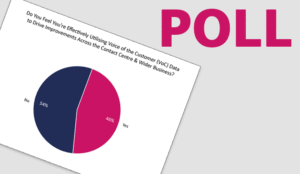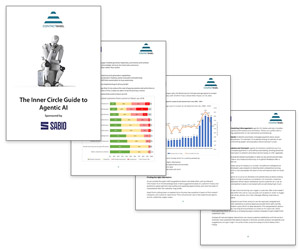Simon Thorpe of Sabio shares his advice for improving your Voice of the Customer (VoC) programme and closing the feedback loop.
While organizations are getting better at collecting feedback, they’re much less good at turning it into insight and acting on it. Whether it’s customer surveys, voice or text analysis, quality monitoring or employee engagement forms, very few businesses seem able to link valuable customer data with action process improvements, and then secure quantifiable business value from their activities.
Why aren’t we doing this better? At Sabio we have identified four main reasons:
- Investment – too many CX programmes aren’t aligned to an organization’s strategic business goals, so actioning the process changes customers ask for is too hard or expensive
- Business silos – across the organization, different parts of the business are busy collecting customer feedback, but it’s rare that it’s being shared. Unless you’re overlaying data sets then the whole process can end up simply annoying customers
- Technology – while lots of different VoC approaches are available, it’s unusual to find common APIs that allow you to join up data sets and achieve a true single view of what customers are saying
- Leadership – without dynamic leaders with a burning desire to know what their customers are really thinking, customer feedback initiatives can quickly lose momentum
Perhaps one of the key reasons for the disconnect is that, for most organizations, customer service and customer experience are still treated as just a contact centre function. And because the contact centre is the part of the business that is tasked with customer contact, it’s often seen as responsible for customer complaints – even when they’re related to processes or touchpoints that are failing in other parts of the business.
So we need to be thinking harder about CX ownership, and also be much more focused on closing the loop when it comes to VoC concerns – both from an external and internal perspective. The ultimate goal here is for different parts of the business to be able to reach out to customers, with feedback centralized and tracked to ensure no annoying question overlaps. Once analysed, learning and actions need to be fed back to customers and also shared with relevant departments across the business that also need to act on findings.
To achieve this, organizations need to make it as easy as possible for customers to offer feedback. We live in a highly-over surveyed climate, so customers should be offered the opportunity to offer feedback on their own terms, perhaps via mechanisms such as Google Home or WhatsApp Survey, or even simple QR codes for ad hoc surveys. When they do this, customers should also be empowered and advised of the process being used to respond to their feedback.
Internally, it’s important to have a clear process for listening, prioritizing and acting on customer insight. This should involve a dedicated team that’s mandated to look and act on insight gathered, and responsible for thanking customers for feedback and sharing resolution plans. Actions then need to be built into coaching and management strategies, becoming part of an ongoing process that can be tracked down to an individual level by continuous feedback.
Looking Beyond the NPS Score
Many VoC programmes seem to get derailed by too much focus on NPS scores. In a way this is understandable, particularly as organizations such as banks now have to publicize these scores so they have built considerable governance around optimizing NPS performance.
But it’s all too easy to hide behind NPS. Because most businesses only tend to follow up on really bad, ‘red alert’ feedback, there are a lot of customers out there who aren’t being engaged. White House research suggests that only 1 out of 26 unhappy customers complain, so while it’s smart to reach out to the super detractors, it’s less smart to ignore what everyone else might be thinking. That’s why it’s so important to close the loop with customers. Indeed it’s estimated that around 11% of customer churn could be prevented by simple, structured outreach programmes.
From an internal perspective, this kind of activity will need to be driven by the contact centre function, but it also needs to be aligned around the different groups that will have to act on VoC feedback.
These range from highly engaged business leaders that require a direct feed of customer insight on their desk every morning, to those managers actively looking for insight into how their own programmes are playing with customers. This kind of insight is invaluable as it can show just how the contact centre is required to triage customer service issues that are triggered by events in other parts of the business.

Simon Thorpe
Actions resulting from VoC feedback also need to be embedded into both contact centre coaching and management processes, and also made accessible to agents so that they can self-correct by having direct real-time access to their own feedback.
At claims management solutions specialist Slater Gordon Solutions Motor (SGMS), sharing feedback directly with partners has led directly to service improvements, which in turn helped SGMS to secure a 15.5 rise in NPS within just six months.
Author: Robyn Coppell
Published On: 22nd Jul 2019 - Last modified: 19th Jul 2022
Read more about - Guest Blogs, Sabio



















